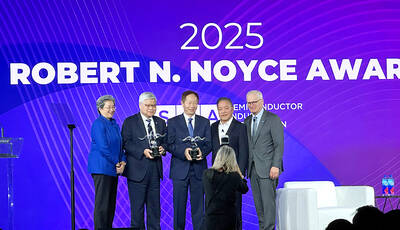Indonesia has warned that its coal supply situation remains critical ahead of a review today of its export ban, unnerving global markets for the fuel used to generate most of the electricity that drives Asia’s biggest economies.
Coal futures in China, the world’s biggest consumer of the fuel, surged yesterday after Indonesia, the top exporter of the coal used in power plants and China’s largest overseas supplier, on Saturday banned exports for January to avoid outages at the generators run by state-owned utility Perusahan Listrik Negara (PLN).
The price rise is among the first signs of the impact of Indonesia’s coal export ban, which threatens the energy security of some of the world’s biggest economies such as China, India, Japan and South Korea.

Photo: Reuters
China’s benchmark thermal coal futures rose by as much as 7.8 percent on the first day of trading since the policy was announced and were at 712.40 yuan (US$111.81) a tonne. That is the highest since Dec. 20 and futures are set for their biggest gain since Oct. 19.
Late on Monday, PLN said it has secured 3.2 million tonnes of coal out of the 5.1 million tonnes of additional supply for January that it needs to avoid widespread outages.
However, it warned that “this critical period is not yet over,” adding that it continued to coordinate with the Indonesian government and other coal suppliers.
At the same time, Indonesian President Joko Widodo said that coal miners, as well as liquefied natural gas producers, must prioritize domestic supply and ensure energy security in Indonesia before exporting.
He threatened to revoke the business permits of miners who failed to meet a so-called domestic market obligation that requires them to sell 25 percent of their coal output to the domestic market at a maximum price of US$70 per tonne.
Indonesian Minister of Finance Sri Mulyani Indrawati said that the ban was enacted to avoid disrupting the recovery of Indonesia’s economy, Southeast Asia’s biggest, from the COVID-19 pandemic.
However, the decision endangers Asia’s economic powerhouses China, India, Japan and South Korea, which together received 73 percent of Indonesian coal exports last year, shiptracking data from Kpler showed.
Indonesian authorities are set to re-examine the export ban today.
The logistics of rerouting coal cargoes to PLN’s power stations will be challenging, because it will require smaller barges rather than large carriers, a Singapore-based coal analyst said.
Indonesian Coal Miners’ Association chairman Pandu Sjahrirof said that as a “very short-term solution” the group’s 10 biggest members would help PLN close the supply gap.
Indonesian State-Owned Enterprises (SOE) Minister Erick Thohir said in a statement that his ministry is working to improve PLN’s coal supply management and infrastructure.
“We at the SOE Ministry will improve the long-term supply contracts,” Erick said, adding that the logistics system and infrastructure would also be upgraded to ensure domestic coal needs are met.
Analysts on Monday warned that India, which consumed more than 15 percent of Indonesia’s coal exports last year, might reroute shipments from other suppliers if the ban persists.
That could mean higher demand for coal from Australia, also a major supplier to Asia.
Shares of Whitehaven Coal jumped as much as 9.2 percent yesterday, the most since July 16.

Shiina Ito has had fewer Chinese customers at her Tokyo jewelry shop since Beijing issued a travel warning in the wake of a diplomatic spat, but she said she was not concerned. A souring of Tokyo-Beijing relations this month, following remarks by Japanese Prime Minister Sanae Takaichi about Taiwan, has fueled concerns about the impact on the ritzy boutiques, noodle joints and hotels where holidaymakers spend their cash. However, businesses in Tokyo largely shrugged off any anxiety. “Since there are fewer Chinese customers, it’s become a bit easier for Japanese shoppers to visit, so our sales haven’t really dropped,” Ito

The number of Taiwanese working in the US rose to a record high of 137,000 last year, driven largely by Taiwan Semiconductor Manufacturing Co’s (TSMC, 台積電) rapid overseas expansion, according to government data released yesterday. A total of 666,000 Taiwanese nationals were employed abroad last year, an increase of 45,000 from 2023 and the highest level since the COVID-19 pandemic, data from the Directorate-General of Budget, Accounting and Statistics (DGBAS) showed. Overseas employment had steadily increased between 2009 and 2019, peaking at 739,000, before plunging to 319,000 in 2021 amid US-China trade tensions, global supply chain shifts, reshoring by Taiwanese companies and

Taiwan Semiconductor Manufacturing Co (TSMC, 台積電) received about NT$147 billion (US$4.71 billion) in subsidies from the US, Japanese, German and Chinese governments over the past two years for its global expansion. Financial data compiled by the world’s largest contract chipmaker showed the company secured NT$4.77 billion in subsidies from the governments in the third quarter, bringing the total for the first three quarters of the year to about NT$71.9 billion. Along with the NT$75.16 billion in financial aid TSMC received last year, the chipmaker obtained NT$147 billion in subsidies in almost two years, the data showed. The subsidies received by its subsidiaries —

Taiwan Semiconductor Manufacturing Co (TSMC) Chairman C.C. Wei (魏哲家) and the company’s former chairman, Mark Liu (劉德音), both received the Robert N. Noyce Award -- the semiconductor industry’s highest honor -- in San Jose, California, on Thursday (local time). Speaking at the award event, Liu, who retired last year, expressed gratitude to his wife, his dissertation advisor at the University of California, Berkeley, his supervisors at AT&T Bell Laboratories -- where he worked on optical fiber communication systems before joining TSMC, TSMC partners, and industry colleagues. Liu said that working alongside TSMC